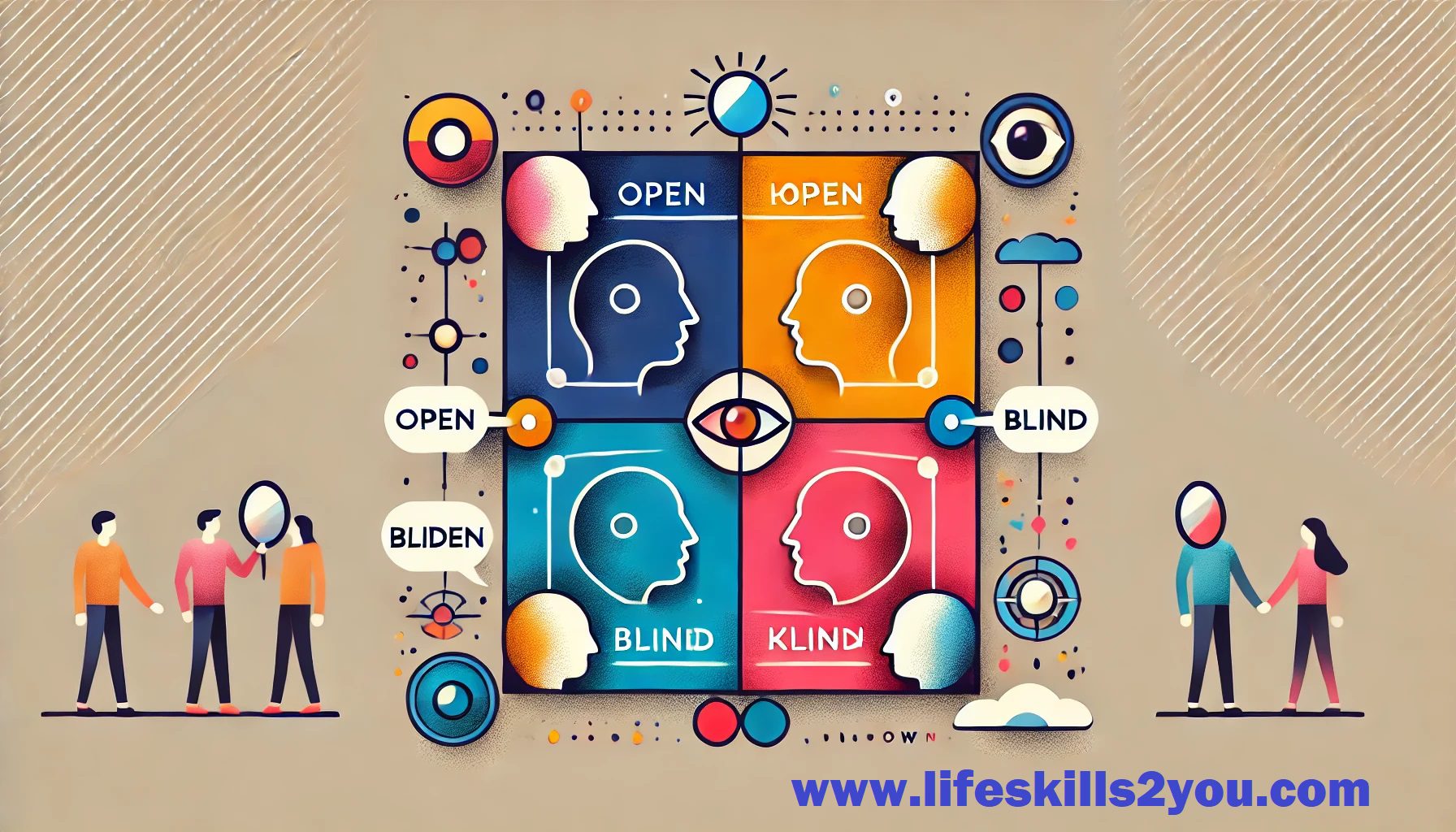Table of Contents
Unlocking the Power of the Johari Window: A Guide to Self-Awareness and Connection
Ever felt like there’s a gap between how you see yourself and how others perceive you? The Johari Window is a fascinating framework that bridges this gap, unveiling the hidden facets of your personality and fostering better communication. Whether you’re striving to strengthen relationships, excel in your career, or simply understand yourself better, this tool holds the key to unlocking your potential.
Let’s dive deep into the Johari Window—your guide to building trust, boosting self-awareness, and achieving meaningful personal growth.
“Knowing yourself is the beginning of all wisdom.”
Aristotle
What is the Johari Window?
The Johari Window is a simple yet profound psychological tool designed to enhance self-awareness and improve interpersonal relationships. Created by psychologists Joseph Luft and Harrington Ingham in 1955, it emphasizes the importance of open communication and mutual understanding. Think of it as a mirror and window rolled into one—a way to see yourself more clearly and let others see the real you.
The Four Quadrants of the Johari Window
The Open Area
This quadrant represents the parts of yourself that are known both to you and others. It’s the space where trust thrives and collaboration flourishes. Expanding this area is vital for authentic connections.
The Blind Spot
Ever been surprised by feedback? This quadrant includes traits others see in you but you might be unaware of. Addressing your blind spots can be a game-changer for personal growth.
The Hidden Area
Your private thoughts, feelings, and secrets reside here. Sharing selectively can deepen relationships and foster mutual trust.
The Unknown Area
This mysterious quadrant holds untapped potential and traits that neither you nor others recognize yet. Exploring this area can lead to incredible self-discovery.

“Until you make the unconscious conscious, it will direct your life, and you will call it fate.”
Carl Jung
The Origins of the Johari Window
The Johari Window was born out of a need to simplify complex interpersonal dynamics. Its creators, Luft and Ingham, aimed to provide a tool that promotes openness, collaboration, and growth. Over the decades, it has become a cornerstone in psychology, leadership training, and team development.
Why Self-Awareness is a Superpower
Self-awareness isn’t just about knowing your strengths and weaknesses; it’s about understanding your impact on others. Like a lighthouse guiding ships, self-awareness helps you navigate life with purpose and clarity.
How to Use the Johari Window in Daily Life
- Invite Honest Feedback: Ask trusted friends or colleagues for insights about your behavior.
- Practice Vulnerability: Share aspects of your hidden self to build trust.
- Reflect Regularly: Take time to uncover the unknown areas through introspection and exploration.
Applications of the Johari Window in Relationships
The Johari Window can transform relationships by fostering open communication and mutual understanding. Imagine a relationship where assumptions are replaced with clarity and trust—sounds amazing, right?
Johari Window and Team Dynamics
In teams, the Johari Window helps bridge gaps, align goals, and enhance collaboration. Teams that understand each other’s strengths and blind spots perform better and communicate more effectively.
The Role of Feedback in Expanding the Open Area
Feedback is the cornerstone of growth. It’s like polishing a diamond—sometimes uncomfortable, but always rewarding. Regular, constructive feedback widens your open area, making you more relatable and effective.
Building Trust Using the Johari Window
Trust is the foundation of any meaningful relationship. By gradually sharing your hidden self and acknowledging feedback, you pave the way for stronger connections.
Self-Reflection Strategies for Personal Growth
- Journaling: Write about your daily experiences and emotions.
- Meditation: Quiet your mind to uncover hidden insights.
- Mentorship: Seek guidance from someone who sees your potential.
Overcoming Barriers to Self-Discovery
Fear of vulnerability and resistance to feedback can hinder self-awareness. But remember, growth begins at the edge of your comfort zone.
The Johari Window in Leadership Development
Great leaders understand their blind spots and leverage feedback to improve. The Johari Window helps leaders build trust, inspire teams, and make informed decisions.
Tips for Facilitating a Johari Window Exercise
- Set Clear Objectives: Define what you want to achieve through the exercise.
- Create a Safe Environment: Ensure participants feel comfortable sharing.
- Encourage Open Dialogue: Foster an atmosphere of respect and empathy.
Real-Life Examples of Johari Window in Action
- Corporate Training: Teams using the Johari Window report higher efficiency and morale.
- Personal Relationships: Couples who explore their open and hidden areas build deeper connections.
Transforming Challenges into Opportunities with Johari Window
Every blind spot is an opportunity waiting to be discovered. Embrace feedback and self-reflection as tools for transformation.
Conclusion
The Johari Window isn’t just a tool; it’s a journey to understanding yourself and others better. By embracing this framework, you unlock the potential to build meaningful relationships, enhance communication, and grow into the best version of yourself. Remember, self-awareness is the first step to self-mastery.
Call to Action
Thank you for exploring this insightful article! If you’re hungry for more knowledge, don’t miss out on our other engaging articles waiting for you. Dive into our treasure trove of wisdom and discover new perspectives on related topics. Click ‘Our Blog’ or ‘How to Guide’ to embark on your next adventure. Happy reading!
1. What is the main purpose of the Johari Window?
It’s designed to improve self-awareness and interpersonal communication.
2. How does the Johari Window improve relationships?
By fostering trust, openness, and mutual understanding.
3. Can the Johari Window be used in the workplace?
Absolutely! It’s a powerful tool for team building and leadership development.
4. How do I expand my open area?
Through feedback, self-reflection, and sharing.
5. What’s the significance of the unknown area?
It represents untapped potential and unexplored traits.
6. Is the Johari Window only for individuals?
No, it’s equally effective for teams and organizations.
7. What are common barriers to self-discovery?
Fear of vulnerability and resistance to feedback.
8. How can I facilitate a Johari Window exercise?
Create a safe environment, define objectives, and encourage openness.
9. Can children benefit from the Johari Window?
Yes, it’s a great way to teach self-awareness and communication skills.
10. Where can I learn more about the Johari Window?
Check out resources like MindTools or PositivePsychology.

